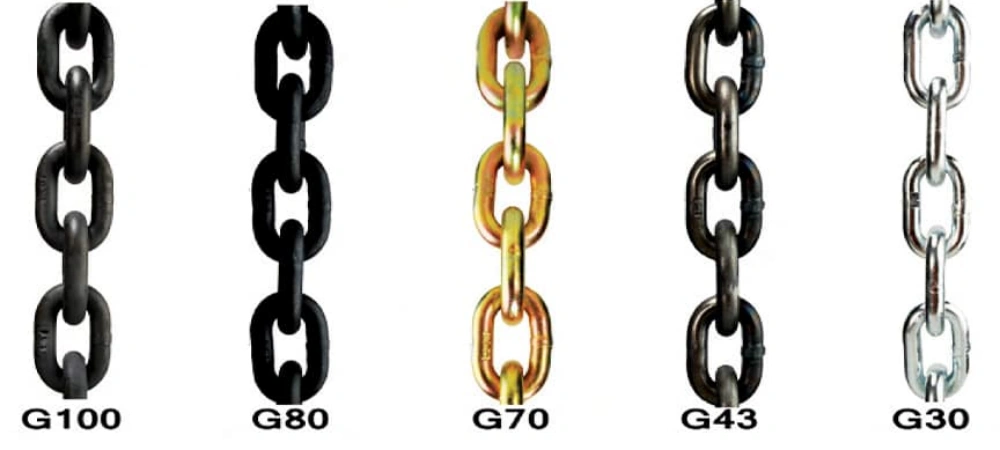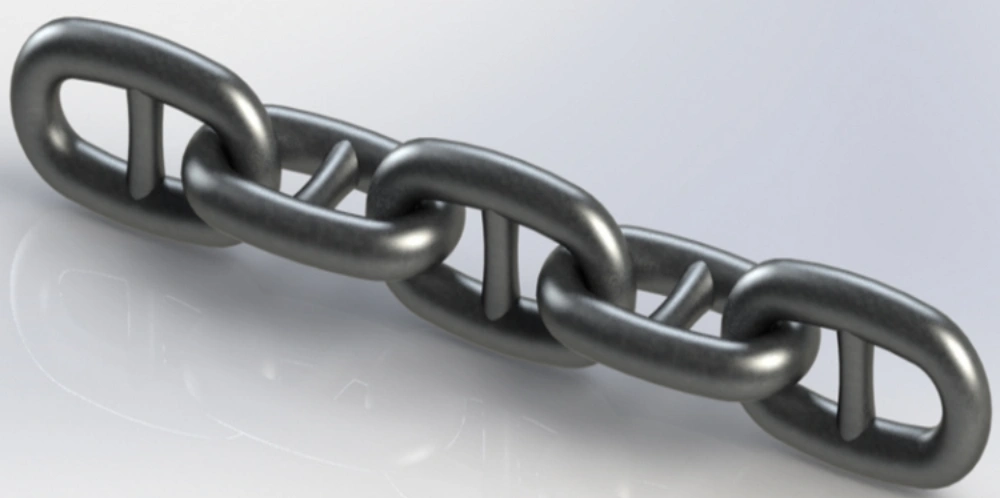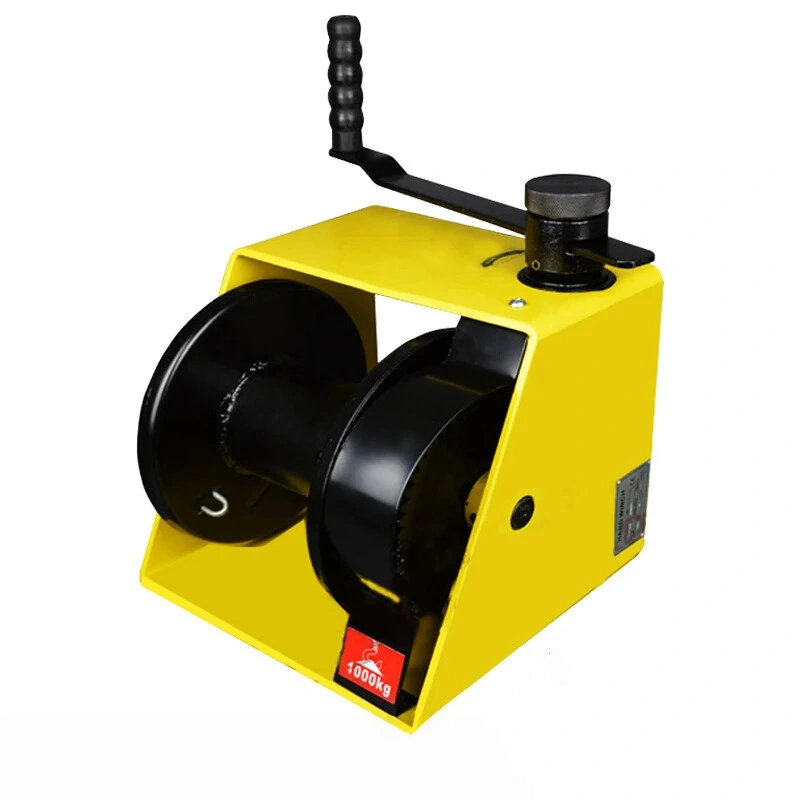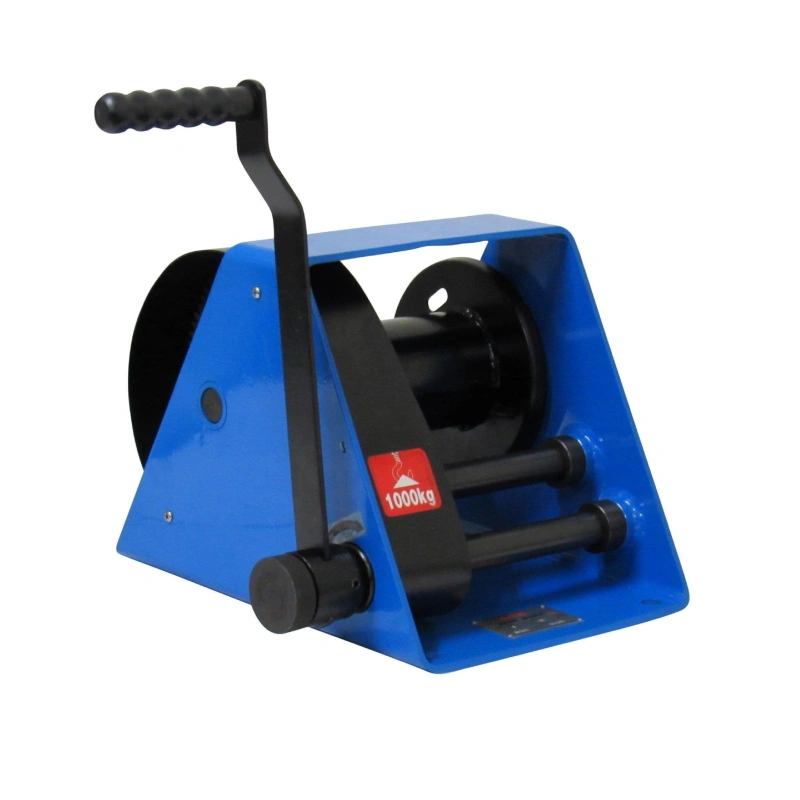When you want to know how to identify chain grade, start by checking for stamped markings and grade numbers on the chain. These markings tell you the strength and purpose of the chain, which is critical for safe use. Quick identification keeps your operations compliant and protects your team.
For example, many industrial chains—such as roller, conveyor, and leaf chains—serve different roles, from automotive assembly lines to lifting heavy loads. The table below shows where common chain grades are used:
Chain Grade | Common Applications |
|---|---|
Roller Chains | Automotive assembly lines, industrial machinery, and agricultural equipment |
Conveyor Chains | Material handling, logistics, e-commerce warehouse operations |
Leaf Chains | Lifting and hoisting applications (forklifts, cranes) |
Silent Chains | High-precision machinery, automotive engines |
Others | Specialty chains for chemical processing, food-grade chains for the food industry |
Powerful Machinery’s certified products display clear markings, making the identification process fast and reliable.
Key Takeaways
Check for stamped markings and grade numbers on chains. These indicate strength and safe usage.
Understand the differences between chain grades. Higher grades support heavier loads and more demanding tasks.
Inspect chains for color finishes. Specific colors help identify the grade and inspection status.
Always verify that the chain grade matches your application needs. This ensures safety and compliance.
Use certified chains from trusted manufacturers. This guarantees quality and adherence to safety standards.
Chain Grades Overview

What Are Chain Grades?
You encounter chain grades every time you select a chain for lifting, towing, or securing loads. Chain grades represent a standardized system that classifies chains based on their material strength, manufacturing process, and intended use.
Each grade tells you how much force a chain can handle before it fails. This information helps you choose the right chain for your job and ensures safety in your operations.
Chain grades matter because they directly affect the performance and safety of your equipment. For example, a chain with a higher grade can handle heavier loads and more demanding conditions. Lower grades work best for lighter tasks, such as agricultural or marine applications.
Powerful Machinery specializes in certified chain grades, offering products that meet strict international standards for quality and reliability.
Here is a quick comparison of common chain grades, their strength, and typical uses:
Chain Grade | Tensile Strength | Load Capacity | Applications |
|---|---|---|---|
Grade 30 | Low | Low | Light construction, agricultural, marine |
Moderate | Moderate | Container securement, towing, and logging | |
Higher | Higher | Load securement, towing by truckers | |
High | High | Overhead lifting, heavy-duty towing | |
Grade 100 | Very High | Very High | Sling component for overhead lifting |
Grade 120 | Ultra High | Ultra High | Rigorous overhead lifting applications |
How are chains graded?

You determine chain grades by looking at the chain’s material composition, heat treatment, and manufacturing process. Industry organizations set the standards for these grades.
Chains must pass specific tests for tensile strength and load capacity before they receive a grade. This process ensures that each chain grade performs as expected in real-world conditions.
The following organizations play a key role in defining and regulating chain grades:
Organization | Role in Chain Standards |
|---|---|
ASTM | Publishes safety standards for chain manufacturing and testing |
ASME | Establishes mechanical engineering standards for chains |
Regulates safety standards for the use and inspection of chains |
Powerful Machinery manufactures chain grades that comply with these standards. You can trust their products for consistent quality and safety. When you choose certified chain grades, you protect your team and your equipment.
How to Identify Chain Grade?
When you work with chains in industrial settings, knowing how to identify chain grade is essential for safety and compliance. You can follow a straightforward process to make sure you select the right chain for your application.
This process involves checking for markings and stamps, observing color and finish, and reviewing product examples from trusted manufacturers like Powerful Machinery.
Markings and Stamps
You should always start by inspecting the chain for visible markings and stamps. Manufacturers stamp the grade number directly onto the chain links, such as “G80” or “G100.”
These markings indicate the chain grade and help you determine the load rating and approved uses. Stamped chains undergo rigorous testing before receiving their grade tag, ensuring they meet safety standards.
Tip: Look for hard stamping on the chain links. Some manufacturers use contrasting colors to make these markings easier to see, especially in low-light environments.
Here are key visual indicators to help you identify chain grade:
Grade numbers stamped on the chain, such as “G80” or “G30”
Tags attached to the chain that show unique identification and inspection status
Proprietary tags that display the Working Load Limit (WLL) and certificate number
Color-coded tags that indicate inspection periods or status
You should always verify that the chain grade marking matches your application requirements. Chains with higher grade numbers support greater loads and offer enhanced durability. Tagged chains provide traceability and confirm that the chain has passed all necessary inspections.
Identify Chain by Color and Finish
Color and finish also play a role in how to identify chain grade. Manufacturers use specific finishes to distinguish between grades and inspection statuses. For example, you may see gold-colored finishes on Grade 70 chains or bright blue and green finishes on Grade 120 chains.
These visual cues help you quickly identify chain grade in busy work environments.
Grade | Color Finish |
|---|---|
Grade 70 | Gold-colored finish |
Grade 120 | Blue, green, or bright colors |
Some chains use colored paint to indicate inspection status or control periods. You should pay attention to these color codes, especially if your workplace uses a color-coded inspection system. Always confirm the meaning of each color with your manufacturer, as color standards may vary.
Powerful Machinery Product Examples
Powerful Machinery provides certified chains with clear markings and finishes, making it easy for you to identify chain grade. Their Grade 80 Chain stands out due to its high tensile strength and compliance with international safety standards.
You will find the grade number stamped directly onto each link, ensuring quick identification and traceability.
Feature | Grade 80 Chain | Grade 70 Chain |
|---|---|---|
Material Composition | Alloy steel with manganese and silicon | Heat-treated carbon steel |
Strength | Higher tensile strength and durability | Lower strength, not for overhead lifting |
Approved Uses | Overhead lifting, heavy-duty recovery | Securing loads during transport |
Safety Standards | Meets OSHA, ASTM, and ASME standards | Not suitable for overhead lifting |
You can also review Powerful Machinery’s Proof Coil Chain, which features clear grade markings and is available in both self-colored and galvanized finishes. This chain is ideal for towing and securing cargo, but is not designed for overhead lifting.
The markings and finishes help you identify chain grade and select the right product for your needs.
Powerful Machinery certifies its chains through a meticulous process:
Step | Description |
|---|---|
Inspection of Raw Materials | Meticulous inspection of all raw materials used in production. |
Comprehensive Testing | Includes chemical analysis, dimensional verification, and proof-load testing. |
Full Traceability | Ensures traceability from steel sourcing to final shipment of products. |
When you need to identify chain for lifting or securing, always check for grade markings, color finishes, and certification tags. Powerful Machinery’s products make this process simple and reliable. You can trust their heat-treated chain for demanding applications, knowing each product meets strict safety standards.
If you want to know how to identify chain grade quickly and accurately, follow these steps every time you select a chain. You protect your team and equipment by choosing certified products with clear grade identification.
Chain Grades and Uses

Grade 30, 43, 70, 80, 100 Explained
You encounter several grades of chain in industrial and commercial settings. Each grade of chain offers unique mechanical properties and serves specific purposes. Understanding the differences between chain grades helps you select the right product for your application.
Chain Grade | Material Type | Working Load Limit (WLL) | Overhead Lifting |
|---|---|---|---|
Grade 30 | Low carbon steel | Not specified | No |
Grade 43 | Higher carbon steel | 2x Grade 30 | No |
Grade 70 | Heat-treated carbon steel | 25% more than Grade 43 | No |
Grade 80 | Alloy, heat-treated steel | Approved for overhead lifting | Yes |
Grade 100 | Alloy, higher strength | 25% more than Grade 80 | Yes |
Grade 30 chains, such as Powerful Machinery’s Proof Coil Chain, work best for light-duty tasks. You use them for agricultural, marine, and general utility applications. Grade 43 chains offer higher strength, making them suitable for container securement and towing.
Grade 70 chains, like those from Laclede Chain, provide even greater ultimate breaking strength and are popular in trucking and transportation for securing heavy cargo.
Grade 80 chains, including Powerful Machinery’s Grade 80 Chain, deliver high ultimate breaking strength and meet standards for overhead lifting and heavy-duty rigging.
Grade 100 chains push the limits further, offering 25% more ultimate breaking strength than Grade 80. You rely on them for critical lifting in oil, gas, and construction sectors.
Applications and Safety
You must match the grade of the chain to your specific industry needs. The differences between chain grades determine where you use each type.
Chain Grade | Industry Usage | Description |
|---|---|---|
Grade 70 | Trucking and Transportation | Used for securing heavy cargo. |
Grade 80 | Overhead Lifting and Construction | High strength and wear resistance for rigging. |
Grade 100 | Oil and Gas Sector | Critical lifting applications require utmost strength. |
You use Grade 70 chains for load securement on trucks and trailers. Grade 80 chains excel in construction and overhead lifting, where safety and ultimate breaking strength matter most. Grade 100 chains serve in oil and gas, mining, and infrastructure projects, where you need maximum reliability.
Safety remains your top priority. You must follow strict standards and protocols to ensure safe lifting and rigging operations. Powerful Machinery’s chain slings and lifting chains comply with international standards, including ISO, ASTM, OSHA, and NACM.
You should inspect chains for nicks, gouges, or excessive wear before each use. Always check identification markings and tags to confirm the chain grade and rated load limits. You must know the weight of your load and never exceed the ultimate breaking strength of the chain.
If you work in chemical environments, consult the manufacturer for recommendations. Avoid using chain slings at extreme temperatures above 400º F or below -40º F. Use adequate protection to prevent damage during use.
Note: Following these safety standards protects your team and ensures compliance with regulatory bodies.
Safety Standard | Description |
|---|---|
Inspection Protocols | Check for nicks, gouges, or excessive wear before each use. |
Identification Markings | Ensure the sling is rated adequately for the load by checking the tag. |
Load Limits | Always know the weight of the load and observe rated load limits. |
Chemical Exposure | Consult the manufacturer for recommendations if used in a chemical environment. |
Temperature Limits | Do not use chain slings at temperatures above 400º F or below -40º F. |
Sling Protection | Use adequate protection to avoid damage to the sling during use. |
Powerful Machinery Solutions
You benefit from Powerful Machinery’s commitment to quality and safety. The company offers a full range of certified chains and chain slings, each designed to meet or exceed international standards.
Powerful Machinery’s Grade 80 Chain provides high ultimate breaking strength and clear identification markings for traceability. The Proof Coil Chain delivers reliable performance for utility and towing applications. Chain slings from Powerful Machinery support heavy loads and offer flexibility for complex lifting tasks.
Powerful Machinery ensures every product meets rigorous standards, including ISO9001, ISO14001, TUV Rheinland, EURO CERT, EAC, Geprüfte Sicherheit, OSHA, ASTM, China Classification Society, and Korean Register. You can trust these products for demanding jobs in construction, marine, transportation, and cargo handling.
The grade of chain you choose impacts compliance with OSHA and other regulatory bodies. Grade 80 and Grade 100 chains are approved for overhead lifting and meet OSHA standards, which is essential for safe rigging operations.
Grade 70 chains, such as those from Laclede Chain, are not approved for overhead lifting, so you must select the correct grade to adhere to safety regulations.
When you select Powerful Machinery’s certified chains, you ensure your operations meet the highest standards for safety and reliability. You protect your team and equipment by choosing products with proven ultimate breaking strength and clear grade identification.
The differences between chain grades matter. You must always verify the grade of the chain before use and follow all safety protocols.
Additional Identification Methods
Trace Codes and Manufacturer Info
You can enhance chain identification by using trace codes and manufacturer information. Modern chains often feature QR codes, Data Matrix codes, or barcodes stamped or tagged onto the product. These technologies allow you to track each chain from production to delivery.
The table below shows the strengths and applications of common identifier technologies:
Identifier Technology | Strengths | Applications |
|---|---|---|
QR Codes | Resilient to deformity, scannable on curved surfaces | Product packaging, anti-counterfeiting |
Data Matrix | Durable, encodes large amounts of data | Industrial applications, logistics |
Barcodes | Simple, widely used | Retail, inventory management |
You may also encounter advanced systems like SICK Label Checker, which uses OCR to read and verify printed texts, barcodes, and 2D codes. This system performs multiple inspections at once, ensuring high-quality output.
Secure QR codes provide extra protection against counterfeiting, which is important for traceability projects.
Chain traceability is the broader process encompassing all product tracking information. Companies are responsible for tracing an item from sourcing and manufacturing to distribution, sale, and eventual disposal.
When you select chains from Powerful Machinery, you benefit from unique identifiers for each product. These identifiers help you track the chain’s history and working load limit. Manufacturers can quickly address quality issues and ensure compliance with regulations.
You gain confidence knowing your chain meets strict standards and can be traced throughout its lifecycle.
Regulatory and DOT Markings
You must check for regulatory markings when choosing chains for transportation or lifting. Chains used for load securement must comply with the National Association of Chain Manufacturers (NACM) Welded Steel Chain Specifications.
These specifications cover manufacturing, dimensions, markings, and inspection requirements. You will find grade numbers, manufacturer codes, and working load limit stamped directly onto the chain or attached tags.
Regulatory markings confirm the chain’s grade and approved uses.
DOT markings indicate compliance with transportation standards.
Inspection tags show the chain’s working load limit and certification status.
You should always verify these markings before using a chain in critical applications. Powerful Machinery’s certified chains display all required regulatory information, making it easy for you to confirm compliance and safety.
Conclusion
You improve safety and reliability when you identify the chain grade correctly. Always check for stamped markings, grade numbers, and certification tags. Use certified chains from Powerful Machinery to reduce accident risks and ensure compliance. Refer to this quick checklist before each use:
Inspect for clear grade stamps and tags.
Assess for cracks, wear, or heat damage.
Confirm manufacturer markings and trace codes.
Inspection Type | Frequency Recommendation |
|---|---|
Initial Inspection | Upon receiving hardware |
Daily Inspection | Before each shift |
Periodic Inspection | Annually or more often as needed |
Consult manufacturer resources for guidance. Reliable chain identification protects your team and equipment.
FAQ
How do you know if a chain is safe for overhead lifting?
You must check the grade marking on the chain. Only Grade 80 or higher chains meet the requirements for overhead lifting. Always verify the manufacturer’s certification and inspect the chain for any damage before use to ensure safety.
Why is chain grade important for safety?
Chain grade tells you the strength and intended use of the chain. Using the wrong grade can lead to failure and accidents. You protect your team and equipment by selecting the correct grade, which is essential for safety in every application.
What should you do if a chain’s markings are missing or unclear?
You should not use a chain with missing or unclear markings. Without clear identification, you cannot confirm its grade or load capacity. This puts safety at risk. Replace the chain or consult the manufacturer for guidance before use.
How often should you inspect chains for safety?
You need to inspect chains before each use and perform periodic detailed inspections according to your workplace policy. Look for wear, cracks, or deformation. Regular inspection helps you maintain safety and prevent unexpected failures during operation.
Can you use any chain for load securement in transportation?
No, you must use chains that meet DOT and NACM standards for transportation. Always check for grade markings and certification. Using the correct chain grade ensures safety and compliance with regulations during cargo transport.


